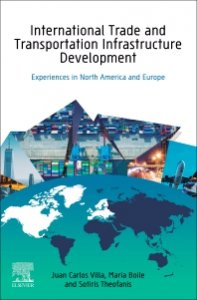
A new book from CAIT-affiliated researchers analyzes the impacts of growing international trade demands on transportation infrastructure. Photo ©Elsevier.
CAIT-affiliated researchers examine the impact of major trade agreements such as NAFTA and the European Union Customs Union, and their implications on transportation systems globally.
Between 1990 and 2010 international trade had tripled. This being the result of sustained economic growth and an increase in interdependence between countries that has emphasized international trade in recent decades.
This increase and how transportation infrastructure handles the growing demand are examined in “International Trade and Transportation Infrastructure Development: Experiences in North America and Europe,” a new book from CAIT-affiliated researchers Dr. Maria Boile and Mr. Sotiris Theofanis.
A Professor at the Department of Maritime Studies at the University of Piraeus; Director of Research at the Hellenic Institute of Transport in Greece; and a Senior Research Scientist at Rutgers Center for Advanced Infrastructure and Transportation (CAIT); Dr. Boile’s research interest and expertise is in the areas of passenger and freight intermodal transport system modeling, freight and maritime logistics, and port and inland terminal operations and management.
Mr. Theofanis is Chairman of the BoD and Chief Executive Officer of the privatized Thessaloniki Port Authority SA, Member of the BoD of the South Europe Gateway Thessaloniki (SEGT) Ltd., and also former director of the Freight and Maritime Program at CAIT and a current Senior Research Scientist.
“This book serves as an ideal reference for researches, students, and transportation professionals who are working on planning and policy, feasibility studies, and more for international transportation systems and infrastructure,” the authors said.
It also analyzes historical trade by mode alongside policy and disputes, supply and demand trends, capacity development, funding mechanisms, and operational characteristics of each mode in relation to the policies that influence them. Looking ahead, the book also analyzes the impacts of new innovate technologies while considering possible future regulatory changes and infrastructure projects.

